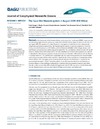Identificador persistente para citar o vincular este elemento:
https://accedacris.ulpgc.es/handle/10553/51627
| Campo DC | Valor | idioma |
|---|---|---|
| dc.contributor.author | Sangrá Inciarte, Pablo | en_US |
| dc.contributor.author | Troupin, Charles | en_US |
| dc.contributor.author | Barreiro-González, Beatriz | en_US |
| dc.contributor.author | Desmond Barton, Eric | en_US |
| dc.contributor.author | Orbi, Abdellatif | en_US |
| dc.contributor.author | Arístegui, Javier | en_US |
| dc.contributor.other | Aristegui, Javier | - |
| dc.contributor.other | Sangra, Pablo | - |
| dc.contributor.other | ORBI, ABDELLATIF | - |
| dc.contributor.other | Troupin, Charles | - |
| dc.date.accessioned | 2018-11-25T02:18:30Z | - |
| dc.date.available | 2018-11-25T02:18:30Z | - |
| dc.date.issued | 2015 | en_US |
| dc.identifier.issn | 2169-9275 | en_US |
| dc.identifier.uri | https://accedacris.ulpgc.es/handle/10553/51627 | - |
| dc.description.abstract | In the framework of the Canaries‐Iberian marine ecosystem Exchanges (CAIBEX) experiment, an interdisciplinary high‐resolution survey was conducted in the NW African region of Cape Ghir (30°38′N) during August 2009. The anatomy of a major filament is investigated on scales down to the submesoscale using in situ and remotely sensed data. The filament may be viewed as a system composed of three intimately connected structures: a small, shallow, and cold filament embedded within a larger, deeper, and cool filament and an intrathermocline anticyclonic eddy (ITE). The cold filament, which stretches 110 km offshore, is a shallow feature 60 m deep and 25 km wide, identified by minimal surface temperatures and rich in chlorophyll a. This structure comprises two asymmetrical submesoscale (∼18 km) fronts with jets flowing in opposite directions. The cold filament is embedded near the equatorward boundary of a much broader region of approximately 120 km width and 150 m depth that forms the cool filament and stretches at least 200 km offshore. This cool region, partly resulting from the influence of cold filament, is limited by two asymmetrical mesoscale (∼50 km) frontal boundaries. At the ITE, located north of the cold filament, we observe evidence of downwelling as indicated by a relatively high concentration of particles extending from the surface to more than 200 m depth. We hypothesize that this ITE may act as a sink of carbon and thus the filament system may serve dual roles of offshore carbon export and carbon sink. | en_US |
| dc.language | eng | en_US |
| dc.publisher | 2169-9275 | |
| dc.relation.ispartof | Journal of geophysical research. Oceans | en_US |
| dc.source | Journal of Geophysical Research C: Oceans [ISSN 2169-9275], v. 120, p. 4516-4533 | en_US |
| dc.subject | 251001 Oceanografía biológica | en_US |
| dc.subject.other | Cape Ghir | en_US |
| dc.subject.other | Cold filament | en_US |
| dc.subject.other | Cool filament | en_US |
| dc.subject.other | Intrathermocline eddy | en_US |
| dc.subject.other | Submesoscale | en_US |
| dc.title | The Cape Ghir filament system in August 2009 (NW Africa) | en_US |
| dc.type | info:eu-repo/semantics/Article | en_US |
| dc.type | Article | en_US |
| dc.identifier.doi | 10.1002/2014JC010514 | |
| dc.identifier.scopus | 84937127941 | - |
| dc.identifier.isi | 000358124100034 | - |
| dcterms.isPartOf | Journal Of Geophysical Research-Oceans | |
| dcterms.source | Journal Of Geophysical Research-Oceans[ISSN 2169-9275],v. 120 (6), p. 4516-4533 | |
| dc.contributor.authorscopusid | 55938118400 | - |
| dc.contributor.authorscopusid | 35275999400 | - |
| dc.contributor.authorscopusid | 56724218700 | - |
| dc.contributor.authorscopusid | 56724190600 | - |
| dc.contributor.authorscopusid | 55409027900 | - |
| dc.contributor.authorscopusid | 7006816204 | - |
| dc.description.lastpage | 4533 | - |
| dc.description.firstpage | 4516 | - |
| dc.relation.volume | 120 | - |
| dc.investigacion | Ciencias | en_US |
| dc.type2 | Artículo | en_US |
| dc.contributor.daisngid | 763696 | - |
| dc.contributor.daisngid | 2075539 | - |
| dc.contributor.daisngid | 20774937 | - |
| dc.contributor.daisngid | 229386 | - |
| dc.contributor.daisngid | 2309784 | - |
| dc.contributor.daisngid | 227201 | - |
| dc.identifier.investigatorRID | D-5833-2013 | - |
| dc.identifier.investigatorRID | No ID | - |
| dc.identifier.investigatorRID | No ID | - |
| dc.identifier.investigatorRID | No ID | - |
| dc.utils.revision | Sí | en_US |
| dc.contributor.wosstandard | WOS:Sangra, P | |
| dc.contributor.wosstandard | WOS:Troupin, C | |
| dc.contributor.wosstandard | WOS:Barreiro-Gonzalez, B | |
| dc.contributor.wosstandard | WOS:Barton, ED | |
| dc.contributor.wosstandard | WOS:Orbi, A | |
| dc.contributor.wosstandard | WOS:Aristegui, J | |
| dc.date.coverdate | Junio 2015 | |
| dc.identifier.ulpgc | Sí | es |
| dc.description.jcr | 3,318 | |
| dc.description.jcrq | Q1 | |
| item.fulltext | Con texto completo | - |
| item.grantfulltext | open | - |
| crisitem.author.dept | GIR IOCAG: Oceanografía Biológica y Algología Aplicada | - |
| crisitem.author.dept | IU de Oceanografía y Cambio Global | - |
| crisitem.author.dept | Departamento de Biología | - |
| crisitem.author.orcid | 0000-0002-7526-7741 | - |
| crisitem.author.parentorg | IU de Oceanografía y Cambio Global | - |
| crisitem.author.fullName | Sangrá Inciarte, Pablo | - |
| crisitem.author.fullName | Arístegui Ruiz, Javier | - |
| Colección: | Artículos | |
Citas SCOPUSTM
13
actualizado el 08-jun-2025
Citas de WEB OF SCIENCETM
Citations
14
actualizado el 08-jun-2025
Visitas
102
actualizado el 16-nov-2024
Descargas
170
actualizado el 16-nov-2024
Google ScholarTM
Verifica
Altmetric
Comparte
Exporta metadatos
Los elementos en ULPGC accedaCRIS están protegidos por derechos de autor con todos los derechos reservados, a menos que se indique lo contrario.
